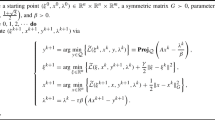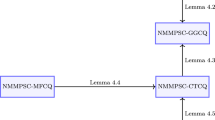Abstract
It is known that the analysis to tackle with non-symmetric cone optimization is quite different from the way to deal with symmetric cone optimization due to the discrepancy between these types of cones. However, there are still common concepts for both optimization problems, for example, the decomposition with respect to the given cone, smooth and nonsmooth analysis for the associated conic function, conic-convexity, conic-monotonicity and etc. In this paper, motivated by Chares’s thesis (Cones and interior-point algorithms for structured convex optimization involving powers and exponentials, 2009), we consider the decomposition issue of two core non-symmetric cones, in which two types of decomposition formulae will be proposed, one is adapted from the well-known Moreau decomposition theorem and the other follows from geometry properties of the given cones. As a byproduct, we also establish the conic functions of these cones and generalize the power cone case to its high-dimensional counterpart.






Similar content being viewed by others
Notes
The definition of \({\mathcal {K}}_{\exp }\) used in (2) comes from [5, Section 4.1], which has a slight difference from another form in [34, Definition 2.1.2] as
$$\begin{aligned} {\mathcal {K}}_{\exp }:=\hbox {cl}\left\{ (x_1,{\bar{x}}) \in {\mathbb {R}}\times {\mathbb {R}}^2\,\bigg |\, x_1\ge {\bar{x}}_2\cdot \hbox {exp} \left( \frac{{\bar{x}}_1}{{\bar{x}}_2}\right) ,\ {\bar{x}}_2>0\right\} . \end{aligned}$$However, one can observe that these two definitions coincide with each other.
References
Alizadeh, F., Goldfarb, D.: Second-order cone programming. Math. Program. 95(1), 3–51 (2003)
Andersen, E.D., Roos, C., Terlaky, T.: Notes on duality in second order and \(p\)-order cone optimization. Optimization 51(4), 627–643 (2002)
Bauschke, H.H., Güler, O., Lewis, A.S., Sendov, H.S.: Hyperbolic polynomials and convex analysis. Can. J. Math. 53, 470–488 (2001)
Boyd, S., Kim, S.J., Vandenberghe, L., Hassibi, A.: A tutorial on geometric programming. Optim. Eng. 8, 67–127 (2007)
Chares, R.: Cones and interior-point algorithms for structured convex optimization involving powers and exponentials. Ph.D. thesis, UCL-Universite Catholique de Louvain (2009)
Chua, C.B.: A \(t\)-algebraic approach to primal-dual interior-point algorithms. SIAM J. Optim. 20, 503–523 (2009)
Chang, Y.L., Yang, C.Y., Chen, J.S.: Smooth and nonsmooth analysis of vector-valued functions associated with circular cones. Nonlinear Anal. 85, 160–173 (2013)
Chen, J.S., Chen, X., Tseng, P.: Analysis of nonsmooth vector-valued functions associated with second-order cone. Math. Program. 101(1), 95–117 (2003)
Chen, J.S., Pan, S.H.: A entropy-like proximal algorithm and the exponential multiplier method for symmetric cone programming. Comput. Optim. Appl. 47(3), 477–499 (2010)
Chen, J.S., Tseng, P.: An unconstrained smooth minimization reformulation of second-order cone complementarity problem. Math. Program. 104(2–3), 293–327 (2005)
Chen, J.S.: SOC Functions and Their Applications, Springer Optimization and Its Applications 143. Springer, Singapore (2019)
Ding, C., Sun, D.F., Toh, K.C.: An introduction to a class of matrix cone programming. Math. Program. 144, 141–179 (2014)
Dür, M.: Copositive programming-a survey. In: Diehl, M., et al. (eds.) Recent Advances in Optimization and Its Applications in Engineering. Springer, Berlin (2010)
Faraut, U., Korányi, A.: Analysis on Symmetric Cones. University Press, Oxford (1994)
Fukushima, M., Luo, Z.Q., Tseng, P.: Smoothing functions for second-order-cone complementarity problems. SIAM J. Optim. 12(2), 436–460 (2001)
Glineur, F.: An extended conic formulation for geometric optimization. Found. Comput. Decis. Sci. 25, 161–174 (2000)
Glineur, F.: Proving strong duality for geometric optimization using a conic formulation. Ann. Oper. Res. 105, 155–184 (2001)
Glineur, F., Terlaky, T.: Conic formulation for \(l_{p}\)-norm optimization. J. Optim. Theory Appl. 122, 285–307 (2004)
Güler, O.: Hyperbolic polynomials and iterior point methods for convex programming. Math. Oper. Res. 22, 350–377 (1997)
Ito, M., Lourenco, B.F.: The \(p\)-cone in dimension \(n \ge 3\) are not homogeneous when \(p \ne 2\). Linear Algebra Appl. 533, 326–335 (2017)
Khanh Hien, L.: Differential properties of Euclidean projection onto power cone. Math. Meth. Oper. Res. 82(3), 265–284 (2015)
Karimi, M., Tuncel, L.: Primal-dual interior-point methods for domain-driven formulations: algorithms. arXiv preprint arXiv:1804.06925
Lobo, M.S., Vandenberghe, L., Boyd, S., Lebret, H.: Applications of second-order cone programming. Linear Algebra Appl. 284(1–3), 193–228 (1998)
Mordukhovich, B.S., Outrata, J.V., Ramiez, C.H.: Second-order variational analysis in conic programming with applications to optimality and stability. SIAM J. Optim. 25(1), 76–101 (2015)
Moreau, J.J.: D\(\acute{e}\)composition orthogonale d’un espace hilbertien selon deux c\({\hat{o}}\)nes mutuellement polaires. Comptes Rendus de l’Acad\(\acute{e}\)mie des Sciences 255, 238–240 (1962)
Miao, X.H., Lu, Y., Chen, J.S.: From symmetric cone optimization to nonsymmetric cone optimization: spectral decomposition, nonsmooth analysis, and projections onto nonsymmetric cones. Pac. J. Optim. 14(3), 399–419 (2018)
Miao, X.H., Qi, N., Chen, J.S.: Projection formula and one type of spectral factorization associated with \(p\)-order cone. J. Nonlinear Convex Anal. 18(9), 1699–1705 (2017)
Nesterov, Y.: Towards non-symmetric conic optimization. Optim. Methods Softw. 27, 893–917 (2012)
Pan, S.H., Chang, Y.L., Chen, J.S.: Stationary point conditions for the FB merit function associated with symmetric cones. Oper. Res. Lett. 38(5), 372–377 (2010)
Pan, S.H., Chen, J.S.: An \(R\)-linearly convergent nonmonotone derivative-free method for symmetric cone complementarity problems. Adv. Model. Optim. 13, 185–211 (2011)
Peres, Y., Pete, G., Somersille, S.: Biased tug-of-war, the biased infinity Laplacian, and comparison with exponential cones. Calc. Var. 38, 541–564 (2010)
Renegar, J.: Hyperbolic program and their derivative relaxations. Found. Comput. Math. 6, 59–79 (2006)
Schmieta, S.H., Alizadeh, F.: Extension of primal-dual interior point algorithms to symmetric cones. Math. Program. 96(3), 409–438 (2003)
Serrano, S.A.: Algorithms for unsymmetric cone optimization and an implementation for problems with the exponential cone. Ph.D. thesis, Stanford University (2015)
Shapiro, A.: First and second order analysis of nonlinear semidefinite programs. Math. Program. 77(1), 301–320 (1997)
Skajaa, A., Ye, Y.Y.: A homogeneous interior-point algorithm for nonsymmetric convex conic optimization. Math. Program 150, 391–422 (2015)
Sun, D.F.: The strong second-order sufficient condition and constraint nondegeneracy in nonlinear semidefinite programming and their implications. Math. Oper. Res. 31(4), 761–776 (2006)
Sun, D.F., Sun, J.: Löwner’s operator and spectral functions in Euclidean Jordan algebras. Math. Oper. Res. 33(2), 421–445 (2008)
Sun, D.F., Sun, J., Zhang, L.W.: The rate of convergence of the augmented Lagrangian method for nonlinear semidefinite programming. Math. Program. 114(2), 349–391 (2008)
Tseng, P.: Merit functions for semi-definite complementarity problems. Math. Program. 83(2), 159–185 (1998)
Vandenberghe, L., Boyd, S.: Semidefinite programming. SIAM Rev. 38(1), 49–95 (1996)
Vinberg, E.B.: The theory of homogeneous convex cones. Trans. Moscow Math. Soc. 12, 340–403 (1963). (English Translation)
Wolkowicz, H., Saigal, R., Vandenberghe, L. (eds.): Handbook of Semidefinite Programming. Kluwer Academic, Boston (2000)
Xue, G.L., Ye, Y.Y.: An efficient algorithm for minimizing a sum of \(p\)-norm. SIAM J. Optim. 10(2), 551–579 (2000)
Zhou, J.C., Chen, J.S.: Properties of circular cone and spectral factorization associated with circular cone. J. Nonlinear Convex Anal. 14(4), 807–816 (2013)
Acknowledgements
The first author’s work is supported by National Natural Science Foundation of China (Grant Number 11601389) and Doctoral Foundation of Tianjin Normal University (Grant Number 52XB1513). The third author’s work is supported by Ministry of Science and Technology, Taiwan.
Author information
Authors and Affiliations
Corresponding author
Additional information
Publisher's Note
Springer Nature remains neutral with regard to jurisdictional claims in published maps and institutional affiliations.
Appendix
Appendix
1.1 The concepts of \(\alpha \)-representable and extended \(\alpha \)-representable sets
For a given convex set \({\mathcal {K}}\), it is \(\alpha \)-representable [5, p. 110] if there exist a finite integer M, scalars \(\alpha _i\in [0,1]\), \(i=1,2,\ldots ,M\), vectors \(c_1,c_2,\ldots ,c_M\in {\mathbb {R}}^3\), matrices \(A_1,A_2,\ldots ,A_M\) with three columns and an appropriate number of rows, a matrix \(A_f\) and a vector \(c_f\) such that
for some artificial variables or modelling variables v. Similarly, the set \({\mathcal {K}}\) is extended \(\alpha \)-representable [5, p. 122] if there exist finite integers \(M_1, M_2\), matrices \(A_\alpha ,A_{\exp },A_f\) and vectors \(c_\alpha , c_{\exp }, c_f\) of appropriate sizes such that
1.2 The decomposition with respect to the circular cone
Consider the circular cone
For any given \(z=(z_1,{\bar{z}})\in {\mathbb {R}}\times {\mathbb {R}}^{n-1}\), the projection mappings \(\varPi _{{\mathcal {L}}_\theta }(z), \varPi _{{\mathcal {L}}^\circ _\theta }(z)\) are respectively given by
where
Combining these results with the Moreau decomposition theorem, the decomposition with respect to \({\mathcal {L}}_\theta \) is
where
with \(w=\frac{{\bar{z}}}{\Vert {\bar{z}}\Vert }\) if \({\bar{x}}\ne 0\) and w is any unit vector in \({\mathbb {R}}^{n-1}\) if \({\bar{x}}=0\) and \(I_{n-1}\) is the identity matrix of order \(n-1\). It is easy to see that
More properties of the circular cone can be found in [45, Section 3].
1.3 Proof of Lemma 1
By definition, \({\mathcal {K}}_\alpha \) is closed, since the functions \({\bar{x}}^{\alpha _1}_1{\bar{x}}^{\alpha _2}_2\) and \(|x_1|\) are continuous on \({\mathbb {R}}^2_+\) and \({\mathbb {R}}\), respectively. To proof that \({\mathcal {K}}_\alpha \) is a convex cone, we only need to verify that it is closed under the addition and the nonnegative multiplication. For any given \((x_1,{\bar{x}})\in {\mathcal {K}}_\alpha \) and \(\beta \ge 0\), one can obtain that
where the first equation uses the fact \(\alpha _1+\alpha _2=1\). Therefore, we have \(\beta (x_1,{\bar{x}})\in {\mathcal {K}}_\alpha \). For any given \((x_1,{\bar{x}}),(y_1,{\bar{y}})\in {\mathcal {K}}_\alpha \), we know
It is easy to see that \({\bar{x}}_1+{\bar{y}}_1\ge 0\), \({\bar{x}}_2+{\bar{y}}_2\ge 0\) and \(|x_1+y_1|\le |x_1|+|y_1|\le {\bar{x}}^{\alpha _1}_1{\bar{x}}^{\alpha _2}_2 +{\bar{y}}^{\alpha _1}_1{\bar{y}}^{\alpha _2}_2\). In order to finish our proof, it suffices to show that
We divide it into the following two cases. Suppose that there exists an index \(i\in \{1,2\}\) such that \({\bar{x}}_i=0\) or \({\bar{y}}_i=0\), it is trivial to show (52). Otherwise, we obtain \({\bar{x}},{\bar{y}}\in {\mathbb {R}}^2_{++}\). Consider the function \(f:{\mathbb {R}}^2_{++}\rightarrow {\mathbb {R}}\):
where \({\bar{x}}:=({\bar{x}}_1,{\bar{x}}_2)^T\in {\mathbb {R}}^2\) and \({\bar{x}}_1,{\bar{x}}_2>0\). By calculation, we obtain
Since \(\alpha _i\in (0,1)\) and \({\bar{x}}_i\) is strictly positive, the Hessian matrix \(\nabla ^2f({\bar{x}})\) is negative definite, which shows that f is concave defined on \({\mathbb {R}}^2_{++}\). Therefore, we have
which is equivalent to the above inequality (52). \(\square \)
Rights and permissions
About this article
Cite this article
Lu, Y., Yang, CY., Chen, JS. et al. The decompositions with respect to two core non-symmetric cones. J Glob Optim 76, 155–188 (2020). https://doi.org/10.1007/s10898-019-00845-3
Received:
Accepted:
Published:
Issue Date:
DOI: https://doi.org/10.1007/s10898-019-00845-3




